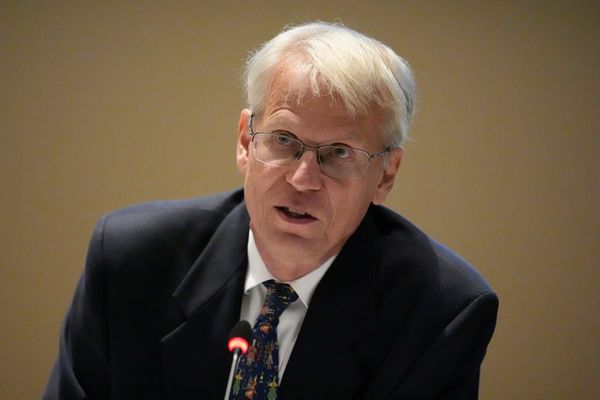
This is not your father's Audi.
You won't find a four-ring badge on the grille. There's barely a grille at all, just thin LED lighting and a familiar name with an unfamiliar logo. It's long, sleek and purple. It's a wagon, but one with a silhouette unlike almost any Audi that's come before it. Inside, a screen sweeps from one door to another. Buttons are few and far between.

The new Audi E5 Sportback—officially the AUDI E5 Sportback, in all-caps, to represent the fact that it's technically from an entirely new brand—is what Audi thinks electric-vehicle buyers in China will want. No wonder, then, that it's built in close collaboration with Chinese automaker SAIC, a company that the Volkswagen Group once essentially taught how to make cars.
One trend was abundantly clear at the Shanghai Auto Show this year: in China, the world's biggest car market, the teacher has become the student.
More and more automakers that once served as the "senior" partner in various joint ventures are turning to their former "junior" partners to get a leg up on battery technology, software and manufacturing techniques. The hope is that they can learn fast enough to compete better in the automotive world's most cutthroat arena, which is full of customers who demand the latest and greatest of everything.
That's where brands like Audi have fallen behind.

A decade ago, Western automakers thrived thanks to a boom in Chinese sales. But Audi is now just one of many that have slumped in recent years, as buyers turn to local brands that are more in tune with their preferences. Its sales sank 11% in China last year. A market that was supposed to be an endless cash cow for these car companies is now a constant source of headaches.
Meanwhile, years of aggressive local and state subsidies, brutal internal competition and a near-total ownership of the global battery supply chain have paid off handsomely for China's homegrown brands. Local customers are flocking to cars from XPeng, Nio, BYD, Zeekr and others.
They're picking up buyers who want the most range and the latest technology at the best price. And those companies learned to move at warp speed to stay ahead of each other, leading to more options than ever and near-constant evolution.

“The happiest group in the coming years is going to be the Chinese car consumer, because they will be presented with a lot of options, reasonable costs and fantastic innovation," said Mingyu Guan, the senior partner and leader in the Advanced Industries practice for consulting firm McKinsey.
Guan, who is based in China, said it's not just advanced automated driving assistance systems (ADAS) or voice-driven AI software or groundbreaking features that Chinese customers want: "It's all of the above."
The Tables Have Turned
Since a Q6 E-Tron wouldn't cut it, Audi needed to call in backup from SAIC, the Volkswagen Group's longtime joint-venture partner. That company rose to prominence in China first by making knock-down kits of VW vehicles for local customers.
But as it (and China's EV supply chain) grew, it has in many ways surpassed what VW can offer. The company makes no effort to hide this: “The E5 Sportback offers the very best qualities of Audi, reimagined for and tailored to customers in China," said Audi Chairman Gernot Döllner in a statement.

The E5 Sportback is even built on a new architecture co-developed with SAIC, the Advanced Digitized Platform, that arguably exceeds what Audi offers in the West. It offers nearly 480 miles of range on China's CLTC cycle, plus the E5 Sportback's zonal electronic architecture "enables next-generation connected vehicle functionality and over-the-air updates for all vehicle systems," Audi said in a statement.
It also has LIDAR for advanced ADAS, can automatically park and recognize traffic lights, and still does zero to 60 mph (0 to 100 kilometers an hour) in just 3.4 seconds.



At the Shanghai Auto Show, it was a similar story across the way at Volkswagen. As customers in China move on from the ID.4 and ID.3, the German automaker debuted three new concept cars that look and feel like something XPeng or Nio might offer: the ID. Evo, ID. Aura and ID. Era.
The first two are EVs and the Era is an extended-range electric vehicle, or EREV—built on an EV platform with a gas engine to recharge the battery. It should be good for around 1,000 kilometers (620 miles) of total range, which could make it a popular option for larger families and people outside of dense cities who want to go the distance.

Those, too, reflect VW's new “in China, for China” strategy. They were built in conjunction with SAIC and another Chinese partner, FAW. Similarly, they offer features you can't get from an electric Volkswagen in the West: 800-volt electrical architectures and AI-powered ADAS systems. VW is also partnering with XPeng on future software systems for China, much as it's teaming up with Rivian for its Western offerings.


The same phenomenon is playing out at General Motors. Buick hasn't been all the rage in China in many years, so now GM is launching its new "Xiao Yao" EV and EREV platform with help from SAIC. The batteries for Buick's new Electra product lineup will also use batteries from China's CATL, which should be able to add 218 miles of range in 10 minutes of fast-charging. SAIC and GM have been partners since the late 1990s, but now SAIC seems to be taking the lead on tech.



Even the world's largest automaker isn't immune to this trend. Toyota's stand at the auto show featured an entire family of bZ electric vehicles, including flagship EV sedans for both the main brand and Lexus. Many of those offerings are the products of team-ups with companies like FAW, GAC and BYD. Toyota isn't trying to hide this: "Toyota is using Chinese minds and methods, focusing on Chinese thinking to develop products and create products that truly meet the needs of Chinese consumers," the automaker announced at the show.
Toyota's new for-China flagship, the bZ7, looks the part: It's sleek, defined by LED lights and features a minimalist but upscale cabin defined by its big central screen.
If automakers in China don't do this, they'll simply be left behind. “The Chinese market is very intense," Guan said, noting that half a decade ago, local companies made up 30% of total sales in China. Today, it's 60%, he said. “In a period of five years, the tables turned.”

Price wars, Guan added, are less critical than technology wars. McKinsey's data indicates that China's customers are often willing to pay more if they feel like they're getting more. And while Western brands are seen as premium, they often aren't seen as high-tech.
"Overall, the strong reputation foreign brands built during the 'fuel' era is not easily transferable to the EV era," as the 2025 McKinsey China Automotive Consumer Insights study put it. (A document about the study was translated into English via AI tools.)
Will These Features Move Outside Of China?
Advanced as those cars are, it's hard for fans of Audi or Buick or Toyota to look at what's happening in China and not feel at least a tinge of jealousy.
Gallery: Shanghai International Auto Show 2025 Live Photos







At least in the United States, the likelihood of these technologies transferring here is low at present. The Biden administration banned Chinese hardware and software in new cars as one of its final acts, and the Trump administration has increased tariffs on Chinese vehicles themselves.
Lawmakers on both sides of the aisle are eager to keep those brands from entering at all, under the auspices of national security—but also protecting local automakers from a level of competition they may not be able to keep up with. So even if these cars are from brands Westerners know, the cars' ties to SAIC and the rest likely preclude them from breaking into the U.S.
But the world is taking notice, Guan said. “I personally believe, and also from our survey, what is actually going on in the Chinese market will be cascading to other markets, particularly when you expose [customers] to all of those innovations," he said. "They will say, ‘Wow, I like it.' And if the cost is also reasonable, then you know, there will definitely be a big appetite.”

Contact the author: patrick.george@insideevs.com







